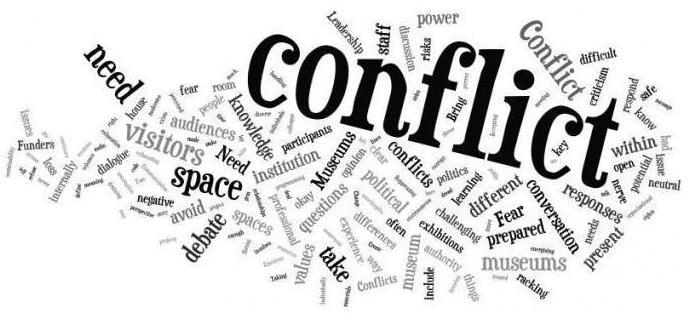Object and subject of conflict: definition, examples
We all live in a society and communicate with a largenumber of people. Not always this communication is pleasant. Quite often people conflict, trying to defend their opinion or get what they want. Perhaps, for some it's amazing, but the conflict can be presented as a clear structured system. Psychology pays much attention to its study. This science is called conflictology and is taught in higher education institutions, as well as at special seminars.

Conflictology: definition and meaning
Psychologists and psychotherapists consider conflictologyone of the most important scientific disciplines. She studies the problem situation from all sides - helps to identify the object and the subject of the conflict, teaches you to regulate it and finish it. In the modern world, such knowledge can be very useful not only for specialists, but also for ordinary people.
As shown by practice, people who own the basicsconflictology, get more pleasure from communication and move faster on the career ladder. We think this is a powerful enough argument to spend our time studying the essence of conflicts in society.
Conflict - a subject of conflictology
Most often, the conflict is understood as a process,the termination of which is the end of the dispute itself. But, in addition, he has his own structure, it does not depend on the circumstances and size of the conflict situation. And interesting is the fact that without the components of the structure the situation itself can not exist. It is a magnitude that is both a part of the conflict and its "fuel", without which the situation goes out and loses its meaning.

Sometimes, instead of the word "conflict"the phrase "conflict situation". These values are rather close, but not identical. Yes, they have absolutely the same structure. But the conflict situation is just part of the conflict - a mold that reflects the entire structure of the conflict as a whole.

Structure: object, subject and participants in the conflict
Since we have already found out that the conflict has its owna clear structure, it can be concluded that it is amenable to analysis. It is the analysis that helps to complete the conflict by identifying all the structural components and determining the needs of all participants in the situation. It is very important to clarify the relationship between them and the conditions in which the conflict is directly taking place.
The structure of the conflict situation in itself looks quite simple:
- object and subject of conflict;
- its participants;
- the environment in which the situation develops.
In fact, the apparent simplicity of the structure of the conflict hides many pitfalls. Therefore, we propose to disassemble all the points in more detail and in detail.
Subject of conflict
The study of the structural vertical is impossible withouta detailed analysis of all its parts. Identify the subject of conflict can be quite difficult even for experienced professionals. Especially not always conflictology separates objects and objects of a conflict situation, but it is absolutely necessary. Otherwise, to resolve the situation, and to clarify the needs of all participants will be almost impossible. After all, the subject, the participants in the conflict and the object are in constant interaction and are firmly connected with each other.
Under the subject of conflict is commonly understoodDisagreements and contradictions between the parties to the dispute, presented in the form of an obvious or fictitious problem. And all parties to the conflict, its subject can be completely different, which does not prevent the parties to fight for their goals. The subject of the conflict can be different material values, religious beliefs, social status and other moments. It should be borne in mind that without an object, any disagreement is simply impossible, it is the most important part of the conflict structure. We can say that this is the very contradiction, which served as a trigger mechanism for the situation. Elimination of these contradictions leads to a note of disagreement on the zero level of aggression.

Most often the subject of conflict is hidden deep in the depthsstructure, it is difficult to determine immediately. In many situations, the length of the dispute is determined by the fact that its subject remains veiled. It should be taken into account that the subject is a mobile quantity. In long conflict situations, contradictions have the properties to develop in a certain amplitude. Until the end of the dispute, several stages of fading and flaring take place, which indicates some instability of contradictions.
Example of a conflict subject
Those who find it difficult to understand what an object isconflict, an example will help to analyze the conflict situation correctly. Imagine that two young men compete because of the girl's attention. One wants to be with her, but the other simply is not ready to give it to her opponent. The desires of both guys are the subject of conflict. Although they relate to one object, the difference between them is obvious.
Another example is the hypotheticalThe situation with the introduction of a large firm graphics with an extended duration of the working day. This topic is discussed at the meeting, and communication is gradually turning into a fierce argument. In this case, the subject of the conflict is the motivation of opponents and defenders of innovation. Moreover, for each participant in the conflict, it can be completely different.

What is the object of conflict?
The object of the conflict situation can be called,because of what it happened. In some cases, it is understandable and does not require time to be identified, but in others it is more difficult to distinguish it than the subject and the subject of the conflict.
The cause of the conflict (or object) can bespiritual, material or social value. In any case, the quarrel arises from the desire to possess this object alone - it stands at the intersection of the interests of all participants in the process. Surprisingly, there are quite a few options for constructing a controversial situation. Most of them are formed when one side is ready to divide the object in order to finish the situation, but the other is opposed and insists on the indivisibility of the object. Solving such a problem is quite difficult.
Types of objects of conflicts
Approaching the analysis of the conflict, do not forget,that objects can differ not only in structure, but also in type or kind. Most often, the following definitions of the typical belonging of the object of the conflict situation are encountered:
- illusory;
- true;
- false;
- actual;
- latent, etc.
Do not dwell on each type separately. It is sufficient to know that the definition of the type of object in certain situations becomes the dominant value in the introduction of the dispute into the final stage.
Examples of highlighting objects and objects of conflict
Remember that it is impossible to overcome the situation, nothighlighting the object and object of conflict. An example of a conflict situation, given in this article, will help you to classify and isolate the structural components of the problem. Imagine that two kids in a sandbox are fighting for a toy left by the third. One wants to play with her in the sandbox, and another - to take him home. Here an indivisible object of the conflict is a toy, despite the fact that it does not belong to any of the participants in the situation. But the intentions of children are a matter of conflict.

Quite often these two concepts are confused with each other, which prevents the solution of the problem. By isolating a false object, you can lose the opportunity for many years to overcome the conflict and embark on a path of mutual understanding.
The difference between an object and an object
In order to have the ability to resolve conflict situations, it is necessary to clearly understand that the subject of the conflict and its object have a number of differences. Briefly they can be represented as follows:
- Resolution of the problem is possible only withelimination of its subject matter. The object of the conflict has no effect on the termination of the situation. It is likely that elimination can occur simultaneously, but that dispute, which has no more object, will be considered exhausted. For example, quarrels over the prize may not subside in the team, even after it is distributed. In this particular situation, the prize is an object, but the desire to receive it is an object in a conflict situation.
- The subject of the conflict can only be something real, because contradictions and struggles are expressed in certain actions. While an object can have many kinds and is often illusory.
- The object of the conflict can be hidden for a long time,but the subject is always very concrete and definite. As an example, the situation with children's grievances, which relate to the object of conflict, is well suited. They are often incomprehensible to parents and seem insignificant. But the expression of this offense by the child is the subject of a controversial situation, and parents always notice and understand these manifestations.
I would like to say that the first time is prettyIt is difficult to penetrate the differences between the object and the subject of the conflict. Therefore, if you can not do this, do not worry - over time the structure of problem situations will become much clearer.
Participants in the conflict
Any dispute is impossible without the participants. And there can be several sides, the minimum number of participants is two. They are also called the core of the conflict, in such a structure the loss of one of the participants automatically stops the situation.
Parties to disagreements may be separatepersons, groups and associations, state structures and entire governments of countries. The structure of the conflict does not change from the status of its participants. Conflictology conditionally divides them into several large groups:
- The main participants in the conflict, or subjects
The subjects of the conflict are opposingparties and take active steps against each other. In the presence of two participants, the appearance of the third and subsequent, as well as their disappearance, does not affect the outcome of the conflict.
In order to quickly solve the problem,it is necessary to identify the initiators of the situation. Moreover, the initiator can have a positive and negative coloration, this does not affect the process in any way, but it clearly characterizes the parties.
2. Support groups
Behind each subject is a certain groupsupport. It can consist of individuals and organizations or be represented by a specific social layer. The support group can take a direct part in the conflict situation and influence it. Groups can also have the status of silent support or an intermediary.
3. Other participants
The list of these individuals is very extensive. Each participant contributes to the development of the conflict. For example, there are organizers of a conflict situation, planning its beginning and development. They interfere with it from time to time and do not change the alignment of the opponents' forces.
Virtually all participants in this group do not haveserious influence on the conflict situation. It is worth noting that the conflict scenario depends more on the rank of its main participants. At the moment they are represented by three groups.
Ranks of the subjects of conflict
Classification of ranks introduced by forcecharacteristics of the subject. The weakest is considered the first rank, and the strongest is the third. It is the power characteristic that defines the boundaries of the conflict and its scenario. So:
- First Rank
These entities are represented by individuals. Their confrontation often has an interpersonal character. As a force, arguments based on personal motivation are used. Such conflicts are short-lived, but clearly pronounced.
2. The second rank
In this case, the parties to the conflict aresocial groups or associations. Sometimes the interests of the group are private, but they are motivated by the interests of the whole community. In such situations, confrontation can last a long time, and arguments in disputes are the power resources of a large group of people who support one idea or pursue a single goal.
3. The third rank
The subjects of the conflict situation arepublic organizations. And the motivator of actions and argument is over-group interest. The forces and resources of such parties to the conflict are constantly replenished, we can say that they are boundless.
I would like to clarify that the ranks are not static. At different stages of the problem situation, subjects can have absolutely different ranks.

The meaning of conflict
It is not necessary to perceive the conflict only withthe negative side. He carries a lot of pluses. Psychologists consider conflict situations a push to the development of society. For example, any problem that has grown into a dispute leads to a relaxation of tension in society. In addition, it allows you to scan any situation and determine the alignment of forces in one particular social group or in different communities.
Far from everyone can understand the structure of the conflict. But those who are fortunate enough to master these useful knowledge, feel much more confident and happier in life. After all, there are no insoluble situations for them.










